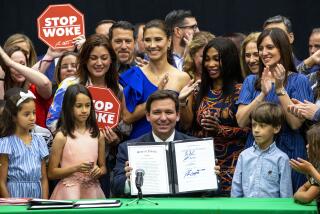De-mystique-ing feminism
- Share via
Considering that the women’s movement of the late 1960s and early 1970s was arguably the largest social movement in U.S. history, it is astounding how little has been written about it. Libraries have shelves of books and dozens of documentary videos about the civil rights movement; only a handful of scholars have studied second-wave feminism, as the movement is called by historians. (The first wave extended from the 1840s to 1920.)
This is partly because, except for a few groups like the National Organization for Women, it was so decentralized. In the 1970s, virtually every U.S. town had a women’s movement. Thousands of stories could be told, so it is hard to generalize. The evidence, if it hasn’t been tossed, often gathers dust in basements and attics.
Historian Sara Evans took on this daunting challenge and gives us a history that is readable and insightful, lively and judicious, strongly argued and open-minded, enthusiastic and critical. The book corrects two myths. One is that New York was the birthplace and center of the movement. The fact that New York is the media capital of the world magnified its sectarian and extremist aspects, its ideological factions and personal ambitions. She balances viewpoints and history from different regions to reveal a more grass-roots movement organized around concrete grievances and needs.
The second myth is that the movement focused mainly on sexual and “lifestyle” issues. Evans shows that campaigns against discrimination in the labor market, in education, religion, law and politics were at least equally important. The clerical workers’ union 9 to 5, for example, began as a Boston women’s liberation project as did Women Employed in Chicago. These activists used new and witty ways to make their points. When legal secretary Iris Rivera was fired for refusing to make coffee, WE held a demonstration outside the prestigious law firm and presented lawyers with a bag of used coffee grounds and instructions: “Step 5 ... Turn switch to on. This is the most difficult step, but, with practice, even an attorney can master it.” Such spontaneous, expressive activism flourished in a decentralized movement that didn’t need to coordinate nationally to take action.Yet this kind of tactical irreverence had a larger impact. Criminalizing sexual harassment began with a single speak-out in Ithaca, N.Y. Feminism among union members led to the Coalition of Labor Union Women, which drew 3,000 to its founding 1974 conference, twice the expected attendance. It became a training ground and support group for female union leaders in their challenges to employers and the union establishment.
Other studies of the women’s movement tend to ignore organizations, not labeled feminist. Evans, in contrast, discusses the YWCA’s influence, especially in its challenges to racism in the 1970s, and women’s struggles for recognition within religious hierarchies. She introduces us to Arvonne Fraser from Minnesota, a congressman’s wife and Democratic Party activist, “one of the Washington insiders whose linkages with feminist outsiders made for
One of the subtler aspects of the book is Evans’ decision not to organize it around the divide between older liberal feminists of NOW and younger radicals of the women’s liberation movement. The former saw their goal primarily as equality; the latter identified with “liberation” because they wanted to transform society, not just make women and men equal within it. Many in her (and my) generation experienced that division as politically defining, and many of us were self-righteous in our identities. But by the 1980s, the two streams had converged as younger women realized that the struggle for sex equality would be long and difficult and older women became less fearful of issues such as reproductive rights, gay rights, domestic violence and welfare rights; and above all as they were forced into unity by an antifeminist backlash. For example, in 1971, Cedar Rapids, Iowa, activists got the municipal civil rights code to include women -- by uniting a group of prominent wives to countercultural leftists: “The important women went on a rampage. They just said, ‘You will do this.’ They were supported by the scary, hippie women ... dripping with beads. Remember that the eleventh commandment of waspdom is, ‘Thou shalt not make a scene.’ We used this as a tool. The men on the [civil rights] commission were ... scared to death that between their wives, who were capable of incredible fury, and these hippies, God knows what would happen.”
One of the book’s most valuable contributions is a discussion of the movement’s strong socialist-feminist stream, which has been largely erased from history. These feminists identified not with socialist bloc countries -- although many supported liberation struggles in Cuba, Africa, Vietnam and elsewhere -- but sought humane democratic alternatives to unregulated capitalism and believed that women could help promote a “cooperative, egalitarian, and caring society.” In practice, the socialist-feminist groups prioritized issues of importance to non-elite women: promoting day care, organizing clerical and health workers, opposing the coercive sterilization of poor women of color and agitating against sexual harassment and for a decent welfare state.
Because socialist-feminists “believed that working-class and minority women should be their primary constituency,” Evans writes, “they also continually berated themselves for their failure to attract such women.” This is one of the most painful aspects of the story. There were some notably successful multiracial and multiclass feminist projects and there were plenty of feminists of color, but they typically did not feel comfortable working in white-majority groups. The second wave coincided with vibrant nationalist movements among African Americans, Latinos, Asian Americans and American Indians, which created pressure on women of color not to criticize their brothers, especially not if they seemed to be in solidarity with white women. But white feminists were not without racism, especially that of the liberal sort -- good intentions but not enough knowledge or humility. Evans cites a bitter example: Angry at the “ingratiation and patronage” she got from white feminists, Hope Landrine “tested the perception that [whites] avoid serious discussion of feminist theory ... with women of color. ... She would engage white women in discussion, challenging them with more and more outrageously absurd statements. The white women never disagreed with her, just smiled and asked a few questions.”
Evans is particularly deft in discussing academic women’s studies, whose practitioners often experience tension between conventional academic priorities and feminist inquiry. Feminist scholars have transformed some of the disciplines and, in the classrooms, made young women more intellectually confident, and young women and men more critical about structures of power. They have stood firm against attacks on “political correctness” and “multicultural” education that were reacting against scholarship and teaching focused on women and of people of color. But Evans also points critically to the jargon and extreme specialization of scholarly writing that isolates many academics from a larger public.
Throughout, Evans handles complex evidence without compromise. The core paradox, as she see it, is that “the creativity ... of feminism
Yet Evans contends most of the failures came from the fact that the very power of the movement produced an awesome backlash. She offers a pithy analysis of how the Moral Majority/Christian Coalition/New Right built its influence, by caricaturing feminist goals and harnessing grass-roots anxiety about a gender-less world.
Evans introduces third wave feminism, which differs from its ancestors in several respects: It is more racially integrated (no doubt partly a result of more people of color in the middle class), more positive about women’s right to be sexy, less absolutist. I’m not convinced this is more than a trickle. But she rightly ends with the emergence of global feminism since the 1980s. At international conferences, thousands learned from each other about issues ranging from soybeans to genital mutilation, from micro-credit to fundamentalism. “While American feminists struggled ... with the dilemmas of multicultural feminism, the international movement shifted leadership ... to women in the developing world and international women’s nongovernmental organizations,” Evans concludes.
More to Read
Sign up for our Book Club newsletter
Get the latest news, events and more from the Los Angeles Times Book Club, and help us get L.A. reading and talking.
You may occasionally receive promotional content from the Los Angeles Times.









